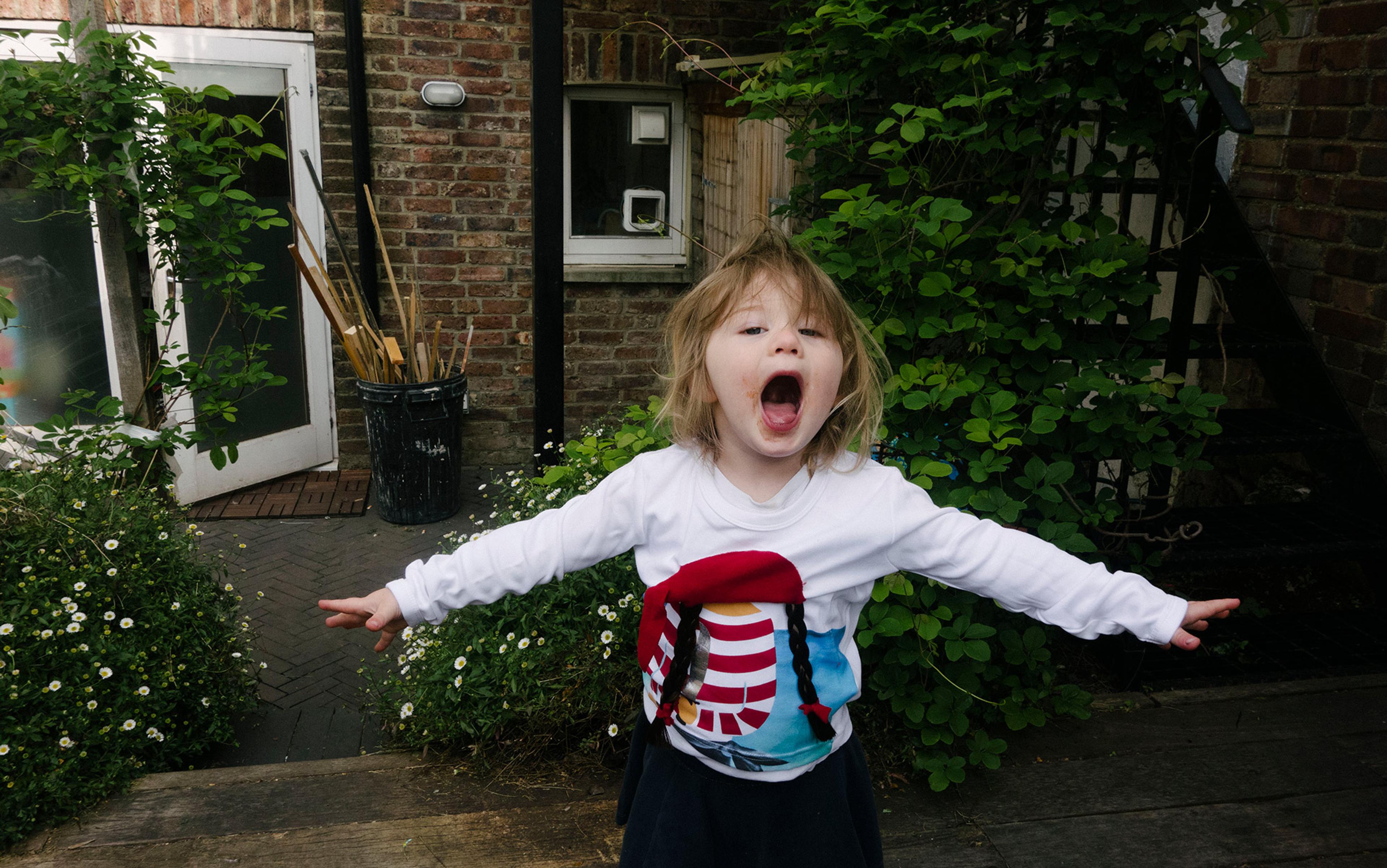On a Saturday morning at my local pool, three one-year-old babies get ready for their weekly swim lesson, their mothers carefully outfitting them in colourful swimwear. One of them, a girl, smiles gleefully at the red ruffle resting below her chin. Another, a boy, escapes his mother’s hold and swiftly runs naked to the end of the locker room, shrieking with anticipation. The third, another boy, softly protests the entire ritual. His brow is set in a knot, despite his mother’s attempts to encourage his enthusiasm. In soothing motherese, she points out the smiling turtles and happy fish that form a little underwater parade on his swim trunks. But his assessment remains static, and his mood does not budge. Eventually, all three babies and their mothers wander out to the pool, towels and toys in tow. But it is not simply pool toys that differentiate these babies’ experience. Another variable is also in play, and it has been on full display as they get ready to swim. It’s what developmental scientists call temperament.
Psychologists define temperament as individual differences in emotional, bodily and attentional reactions to sights, sounds, smells, tastes, touch, etc, as well as in the self-regulation of emotion, behaviour and attention. Within the first few days of life, babies make their inborn temperament known to parents. Some babies are sunny and agreeable, some sober, some without any predictable sleeping and eating patterns, some incessantly cranky, and others fully adaptable to the changing circumstances that surround them. In 1956, the psychiatrists Alexander Thomas and Stella Chess, struck by the blame placed on mothers for child outcomes, launched the New York Longitudinal Study to investigate infants’ innate dispositions and their effect on long-term development including personality, school achievement, peer relationships, parent-child interactions and mental health. They recruited 133 infants (66 males, 67 females) from 82 white, middle-class families, and collected data on them in childhood, adolescence and young adulthood for 32 years. Their goal was to understand how children contributed to their own development, and to identify whether and how child temperament interacts with the environment to produce specific outcomes.
Thomas and Chess identified nine dimensions of temperament: activity level, regularity, approach, adaptability, intensity, sensory threshold, mood, distractibility and persistence. Using these dimensions, they distinguished three broad temperamental types: easy, difficult and slow-to-warm-up. Most babies, roughly 40 per cent, fit the category of ‘easy’ meaning they were generally in a positive mood, adapted well to new situations and routines, and were quickly soothed when upset. A smaller proportion, about 10 per cent, were ‘difficult’ due to their generally negative and intense reactions to minor events, the length of time required to calm down, and their lack of predictable eating, sleeping and digestive rhythms. Another 15 per cent were described as ‘slow-to-warm up’ due to their overall uneasiness and apprehension in new situations – a sort of chronic vigilance – but also their ability to adapt with time and support. If you’re doing the math, you will have noticed that about one-third of infants could not be classified using this system, suggesting that some babies had mixed dispositions or that these initial dimensions needed to be refined or extended.
Nonetheless, Thomas and Chess had effectively nixed the idea that babies are born ‘blank slates’ who passively receive and are moulded by the environment. Their work flipped the script on psychological views that had paid almost exclusive attention to the role of parents and the environment on child development, while ignoring the influence of the child’s innately endowed predispositions. Thomas and Chess, working with colleagues who progressed their original study, showed that neonates, sometimes just hours old, begin to inadvertently affect the physical and social environment by adapting, resisting, observing, reacting or ignoring it in ways nudged by their biological temperament, and that parents, siblings and other close people change the environment and/or their own behaviours in response. In other words, the environment and the baby have a dynamic bidirectional relationship from the very beginning, changing in response to each other. What’s more, this influence means that babies play a major role in their own development.
Additional work by Mary Rothbart and Jerome Kagan expanded on what Thomas and Chess had found. Rothbart explored other temperamental dimensions such as soothability and fear, as well as redefining the dimension of ‘approach’ as a baby’s positive excitement and rapid advance toward new situations. The baby in the locker room that morning who shrieked with delight while running naked toward the pool deck was the poster child for temperamental approach: he was thrilled at the prospect of the pool and did not want to wait for his mother (or his bathing suit!) to begin. Rothbart also divided mood and intensity into several additional subtypes. Weeks prior, I’d witnessed a toddler who was so intensely distressed upon arriving at the pool, she couldn’t make it into the building. She rolled on the sidewalk in front of the door, shifting between crying and screaming, and refused her parents’ gentle requests for reconsideration. Her display seemed rooted in a fear that could not be alleviated, whether by the security of her parents’ presence, or by a tiny rubber duck offered by a lifeguard entering the building. Her parents were dismayed both by her reaction and by their inability to soothe her immediately. Her reaction was not a display of wilful disobedience. Instead, it was a type of terror, a temperamental quality known as ‘reactivity’.
It is this temperamental variable – reactivity – that became the focus of Kagan’s work, partly because it is so easy to observe in young infants’ vocal, bodily, emotional and physiological arousal, even when presented with unfamiliar but innocuous situations. In one test, Kagan and colleagues presented four-month-olds with a mobile swinging gently a few feet in front of them. Most infants observed the mobile calmly, but about 20 per cent became quickly overstimulated and agitated. They vocalised, tensed their muscles, arched their backs, and fussed or cried. That simple test turned out to have strong predictive power. Using this assessment, infants deemed ‘reactive’ at four months of age were more likely to be shy as toddlers, socially inhibited as children, and anxious as adolescents. In a long-term follow-up, Kagan’s test could even distinguish between young adults who were or were not anxious; the former group had been reactive to the mobile test as infants, while the latter group had not. It appeared that infant temperament could extend its reach all the way into young adulthood.
Recent studies have found that three broad aspects of temperament in particular are especially useful in predicting long-range developmental outcomes. The first is reactivity or negative emotionality, referring to general negative mood, intense negative reactions, and distress either when limits are imposed (eg, anger) or in new situations (eg, fear). The second is self-regulation, which researchers refer to as ‘effortful control’ of feelings (eg, self-soothing) and of attention (eg, able to hold focus). The third goes by several names including approach-withdrawal, inhibition, or sociability, and refers to the tendency to approach new people and situations, or to be wary and withdraw. There are additional levels of these dimensions, but these three have best withstood scientific tests of reliability and validity across infants, children and teenagers. Hundreds of studies have subsequently and unequivocally demonstrated that temperament is a driving factor in child development that is at least as important as everything that comes after a baby enters the world, including parenting.
Aside from its early appearance, there is other evidence – from animals, neuroscience, twins, and longitudinal studies – that temperament is biologically based. First, it’s not just human infants who exhibit temperamental characteristics. Other juvenile mammals do too, including dogs, elephants, dolphins and even squirrels. This suggests temperament is part of a shared biological system. Kagan explains temperament as an inherited bias in the brain’s neurochemistry. Specifically, all mammalian brains include a small structure, the amygdala, which serves as part of a built-in alarm system. The amygdala is largely responsible for assessing threat and, if detected, for signalling the sympathetic nervous system into action via the fight-or-flight response. In reactive individuals, the amygdala is more easily excited, so the alarm system is triggered at a lower threshold. Although the environment and experience can alter the responsiveness of the amygdala in either direction, some individuals – including the reactive four-month-olds in Kagan’s study – are born with a bias to perceive threat more readily. Other work has similarly shown that negative emotionality and withdrawal in babies is marked by greater activity in the right frontal brain, while the opposite temperamental pattern is associated with greater activity in the left frontal brain.
Twin studies lend further evidence that temperament is genetically endowed. In one research design, scientists compared identical twins (who share 100 per cent of their genes) with fraternal twins (who have 50 per cent of their genes in common) on temperamental qualities. If identical twins are more similar than fraternals, then scientists can reasonably conclude the trait is heritable. In another research design, scientists used the temperament scores of one twin to predict the scores of the co-twin. Both of these paradigms consistently find high heritability for most dimensions of temperament including sociability, emotionality, activity, attention span persistence and soothability, for example.
Excessively irritable infants are more likely to become children who cannot regulate their anger or impulses
Longitudinal studies following infants over the course of their development reveal the extent to which temperament at birth influences child development. Many studies have tracked long-term developmental outcomes associated with specific dimensions of temperament. Broadly speaking, negative temperamental reactivity and overall difficult temperament are related to later oppositional behaviour, defiance and conduct issues, known collectively as ‘externalising problems’, and are also predictive of substance use in adolescence.
Using longitudinal follow-up studies that begin in infancy, Joel Nigg has found that excessively irritable infants are more likely to become children who cannot regulate their anger or impulses when frustrated, while excessively exuberant infants are more likely to become impulsive children. In both cases, the development of effortful control is inhibited. These findings have led Nigg to propose that ADHD is not a disorder of inattention or hyperactivity, but instead a disorder of temperament-based self-regulation. On the other hand, temperamental shyness and inhibition are related to ‘internalising problems’ such as anxiety. Another internalising problem, depression, has been associated with temperamental negative mood, low adaptability and the tendency to withdraw from, instead of approach, new objects and situations.
Notably, infants who exhibit the temperamental ‘approach’ may be more likely to develop into curious children. The neural basis for curiosity lies in the brain’s nucleus accumbens, a structure involved in the ‘seeking system’ that underlies the motivation to explore and understand the environment. The nucleus accumbens provides the link between motivation – for example, the drive to gain a reward, like eating food or lowering stress – and the action required to get that reward. In one study, we followed up on nearly 60 children who had participated as babies in various developmental studies conducted by my lab where we measured their temperament. The children, averaging five years of age at follow-up, were then assessed for curiosity. Temperamental approach at six-months significantly predicted childhood curiosity, suggesting that curious children may start life endowed with an inborn motivational inclination. These children may get a nudge from nature to expect that new experiences will be positive, and thus be motivated to seek and remain engaged with novelty. Importantly, these children were also endowed with the self-regulation needed to maintain their interest in and effort toward exploring. Since temperament data in infancy predicted this quality in childhood, nature likely plays a hand in this outcome.
The long reach of infant temperament into childhood and beyond speaks to its potential stability, and seems to support temperament as biological and unchanging. However, the environment can offer a consistent response to temperamental qualities encouraging them to remain intact. Imagine the shy infant, for example, who is likely to encounter similar reactions to their shyness from family members, peers, care providers and strangers. Since the shy infant will be less likely to accept social overtures and opportunities, over time, others may be less likely to offer them. Consequently, the shy baby is less likely to have the very social opportunities that could encourage boldness.
Several studies have explored cross-cultural differences and similarities in temperament, finding that although some aspects of temperament, like perceptual sensitivity and activity level, cut across cultures, other dimensions – like approach and rhythmicity – vary and may reflect culture-specific parenting practices. Since American parents tend to value independence, they are more likely to encourage independent ‘approach’ behaviour in their babies. These findings acknowledge that, although temperament is endowed by nature and makes some psychological outcomes more probable, it is also amenable to influence by the environment, such that no particular outcome is guaranteed. Welcome, parents.
Although Thomas and Chess demonstrated inborn temperamental differences, they did not assert that temperament was more responsible for child outcomes than the environment. Instead, they suggested that optimal child development rested on the ‘goodness of fit’ between the child’s innate capacities and characteristics, and the demands of the social environment, including parental expectations and practices. A loud or chaotic environment would be a particularly poor fit for a highly reactive infant with naturally low sensory thresholds and an inability to self-soothe. On the other hand, a monastic environment would be a poor fit for a child intrigued by novelty. It is this interaction, in which a child’s temperament confronts the environment – and vice versa – that Thomas and Chess proposed is responsible for long-term outcomes. In other words, the environment matters.
Most of the research on the effects of parenting on temperament has focused on infants with difficult temperamental qualities, like irritability and reactivity. Generally speaking, these qualities are associated with parental punitiveness or withdrawal, which together can contribute to the externalising behaviour problems described earlier. However, other work has shown that – depending on parents’ age and understanding of their baby’s irritability – many parents of difficult babies double down on efforts to be positive, like showing more warmth and patience.
Take the highly reactive toddler who refused to enter the swim facility whose parents showed remarkable patience and calm. They spoke in low tones, offered comfort and support, sat on the ground with her, and held her closely until she finally calmed. Eventually, she agreed to look through the oversized windows and simply watch the kids who were already inside enjoying the water. That was as far as her parents pushed their agenda, since that was as far as she was able to go that morning. These kinds of efforts have been found to enhance reactive children’s overall social development.
Gentle parental discipline is enough to promote the development of conscience in fearful children
Longitudinal work by Jay Belsky, who followed temperamentally negative babies for more than a decade, found that they thrived academically and socially – in some cases, even more than their temperamentally easy counterparts – if their parents had been warm, responsive and sensitive to their early demands. Belsky’s work has generally shown that temperamentally vulnerable children are more susceptible to the negative effects of poor parenting and environments but also gain more benefit from supportive environments, including warm, responsive parenting. Consistent with this, our lab found that babies who were temperamentally less likely to smile and laugh at six months had more secure attachments by their first birthdays. Presumably this is because parents had spent more time and effort in trying to improve their infants’ general mood, which paid off in attachment security.
Another line of research has followed infants with a fearful temperament, like the ‘slow-to-warm-up’ style first identified by Thomas and Chess. Here, parenting makes a clear difference. Although parents may be inclined to overprotect or overcontrol the vigilant child or their environment, this tends to exacerbate the child’s natural wariness and promote social withdrawal. Much of the work on fearful temperament has specifically examined its relationship to the development of moral conscience, as inhibition tends to be a marker of self-control. In fact, fearful temperament is related to the development of empathy, guilt and shame. Researchers such as Grazyna Kochanska have found that gentle parental discipline is enough to promote the development of conscience in fearful children; meanwhile, in fearless children, moral conscience relies more on the quality of the child’s attachment to their caregivers, which encourages the child to value relationships and embrace ‘the Golden Rule’.
Additional work in our lab found a difference in parental influence on fearless and fearful infants. In a recent experiment, six-month-olds were shown a white mannequin head with extra-large ‘googly eyes’, an ambiguous stimulus that could arouse wariness or amusement. In different experimental conditions, parents were instructed to either laugh at the mannequin or to show fear toward it. Temperamentally fearful infants could be persuaded to stay engaged with the stimulus simply by observing their parents’ laughter. On the other hand, parents’ fear cues toward the stimulus did nothing to dissuade fearless infants from being engrossed by the mannequin. So the environment, including parenting, can influence temperament and make some psychological outcomes – including sociability, approach and even moral conscience – more probable. However, in acutely stressful environments, a child’s temperamental capacities to self-regulate their feelings, behaviour and attention are likely to matter more.
After swimming, I again see the three babies in the locker room, all shivering under their towels, their mothers recalling their recent watery successes. The delightful shrieker is attempting to escape the tight wrap of his towel like a little Houdini, his mother laughing in disbelief at his continued energy. The baby in the red ruffle swimsuit is snacking calmly on fish-shaped crackers, looking on with an amused smile. And the previously glum baby wears a look of satisfaction as his mother, having anticipated his sensitivity to the transition, reunited him with his favourite toy. Nature and nurture on full display at a community swimming pool on a Saturday morning.




























